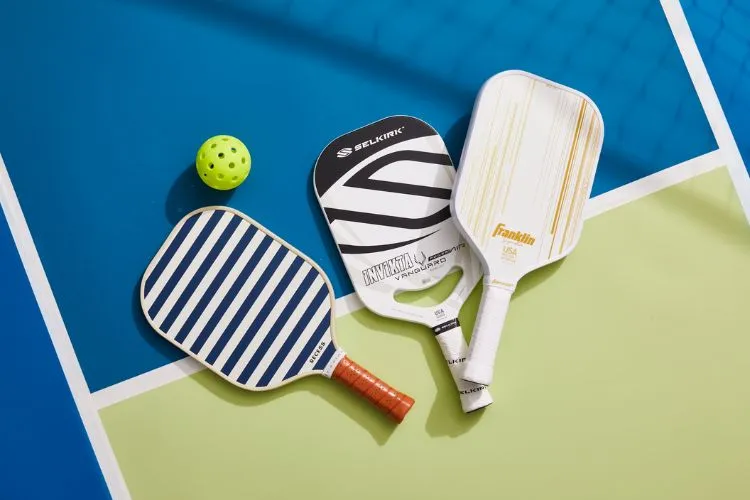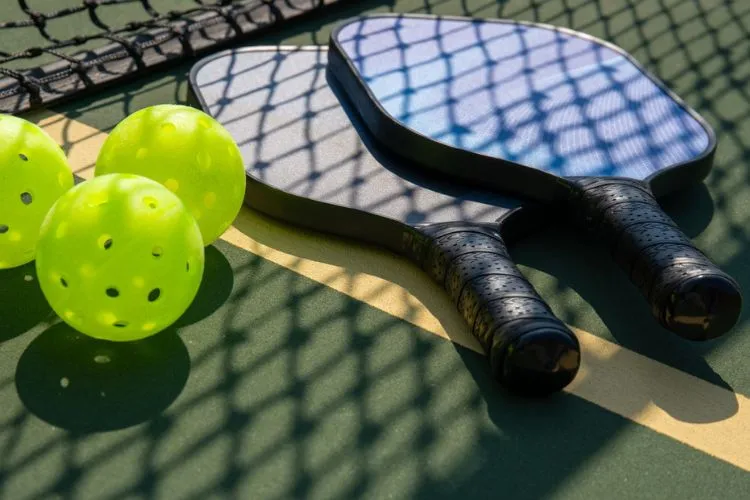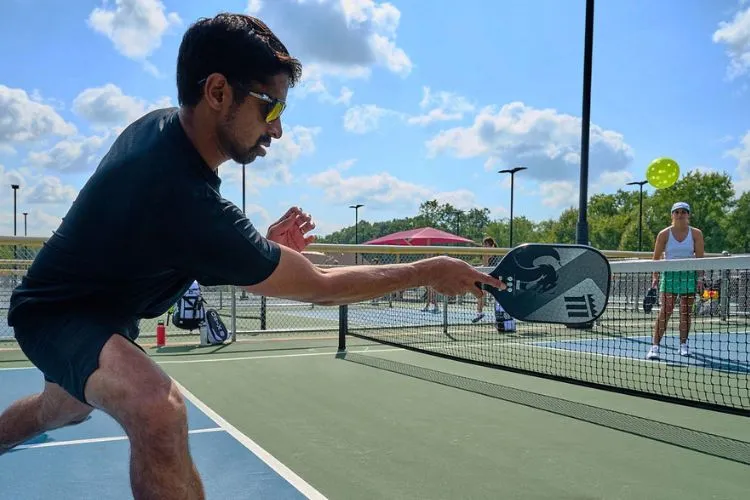Pickleball, the amped-up sport that combines elements of tennis, badminton, and table tennis, has taken the sports world by storm. Central to the game is the paddle.
With varieties aplenty, finding the perfect paddle can pose a challenge. Are edgeless pickleball paddles better?

Are edgeless pickleball paddles better?
Whether edgeless pickleball paddles are better is subjective and dependent on a player’s needs and style.
Edgeless paddles offer various benefits such as a larger sweet spot, increased playing surface, and quicker swinging due to their lighter weight. It can aid players in defense and swift game plays.
However, they lack an edge guard which can lead to mis-hits and less stability for off-center hits. This lack of stability could affect consistency, especially for beginners.
Traditional paddles with an edge guard offer more stability and are more durable due to the added protection from scrapes and drops.
Therefore, the “better” choice varies based on your skill level, gameplay preference, and the importance you place on paddle durability.
Why Edgeless Pickleball Paddles?
Edgeless pickleball paddles lack the protective edge guard found on traditional paddles. This absence adds a unique spin to the paddle design. Some players swear by them for their distinctive feel and gameplay benefits.

Benefits of Edgeless Pickleball Paddles
Every player carries specific needs to the court. For some, edgeless pickleball paddles fulfill these needs with unrivaled precision.
One key benefit often cited is the larger sweet spot. The sweet spot is the paddle’s optimal ball-striking location.
A larger sweet spot can improve strike efficiency. Edgeless designs maximize this treasured space.
The boost in playing surface can also influence swing dynamics. Traditional paddles surround the playing surface with an edge guard.
Removing it frees the extra millimeters, allowing quicker, smoother swings.
Lighter weight is another reason some players side with edgeless paddles. Without the added weight of an edge guard, the paddle feels lighter.
This reduction can lend better control, enhancing the overall gaming experience.
Drawbacks of Edgeless Pickleball Paddles
On the flip side, edgeless pickleball paddles have limitations. The boosted sweet spot could morph into a double-edged sword.
Off-center hits on edgeless paddles could lead to mis-hits, thwarting intended ball direction.
The edge guard on traditional paddles provides stability. Missing it leaves edgeless paddles prone to twists and wobbles during off-center strikes.
This lack of stability could affect consistency. So, while edgeless paddles provide benefits, trade-offs exist.
You may also find useful: 13mm vs 16mm Pickleball Paddle | Best Edgeless Pickleball Paddle
Edgeless vs. Edge-Trimmed Pickleball Paddles
Placing edgeless and edge-trimmed pickleball paddles side by side highlights their differences. It also uncovers the nuances that could impact a player’s game.
Performance, durability, and personal preference are considerations at play.
In terms of performance, edge-trimmed paddles offer more stability. Their edge guards provide a reinforcing grip, reducing the risk of wobble.
Off-center hits find solace in this stability. Edgeless paddles, in contrast, offer larger sweet spots.
When it comes to durability, edge guards on traditional paddles shield the paddle surface. They take the brunt of scrapes and drops, sparing the playing surface.
Edgeless paddles lack this protective feature. It leaves them more vulnerable to surface damage.
In the end, the question boils down to personal preference. No paddle rules them all. Each brings unique attributes to the table.
Some players prefer the streamlined feel of edgeless paddles. Others choose the rugged durability of edge-trimmed varieties.
Ideal Player Profile for Edgeless Pickleball Paddles
Edgeless pickleball paddles offer unique benefits and drawbacks that cater to certain player types.
By examining various skill levels, playing styles, and preferences, we can identify the ideal player profile that might get the most benefit from using edgeless paddles.

Skill Level
Intermediate to Advanced Players: Edgeless paddles provide a larger sweet spot and playing surface, which benefits players who have a solid grasp of ball control and shot precision.
Intermediate and advanced players may find these features advantageous in elevating their game, as they can take advantage of quicker reflexes, better defense, and faster volleys that edgeless paddles offer.
Beginners: Those new to the game should be cautious when starting with edgeless paddles. The lack of an edge guard results in reduced stability during off-center hits, which could be challenging for beginners still lacking control and consistency in their shots.
So, beginners might want to start with a traditional edge-guarded paddle to build a stronger foundation before transitioning to edgeless paddles.
Playing Style
Offensive Players: Players with aggressive playing styles who rely on quick reactions, fast volleys, and powerful strikes may find edgeless paddles advantageous.
The increased playing surface allows for more seamless swinging action and better ball placement during aggressive plays. This could help offensive players gain an edge over their opponents.
Defensive Players: Defensive players who focus on accuracy and control may also benefit from using edgeless paddles.
The lighter weight offers greater maneuverability, enabling them to quickly respond to opponents’ shots or to gain better ground positioning.
All-Around Players: All-around players, who balance both offensive and defensive strategies, may also experience improvements in ball control and versatility when using edgeless paddles.
However, they should be aware of potential drawbacks such as reduced stability for off-center hits, which could affect overall performance.
Personal Preference
Finally, personal preferences play a crucial role in determining the suitability of edgeless pickleball paddles. Players who put more emphasis on improving their game technique and are willing to adapt to the nuances of using edgeless paddles might benefit over time.
However, players who prioritize durability and stability might prefer traditional edge-guarded paddles, as they provide better protection and consistency for off-center hits.
In conclusion, intermediate to advanced players, offensive and defensive players, and individuals prioritizing technique improvements and adaptability, may benefit the most from edgeless pickleball paddles.
Ultimately, players should weigh the benefits and drawbacks based on their specific needs, skill level, and preferences to make an informed decision.
Conclusion:
So, are edgeless pickleball paddles better? They offer a host of benefits – a larger sweet spot, quicker swings, and less weight. They also deliver unique drawbacks such as reduced stability.
The comparison with edge-trimmed paddles uncovers further considerations. In reality, no definitive answer fits all.
Players should weigh the advantages and limitations. Consider personal play style and preference. In the vast world of pickleball paddles, the perfect fit awaits.
The goal is to find it. So, go forth, experiment, and let personal experience guide the way.

Pickleball’s more than a game to me—it’s a passion. I write, sharing its highs and lows, the thrills and the lessons. Some tales might draw you to the court, while others give a hint of the game’s magic. So, curious about my journey? Ready to dive deep into the world of pickleball with me? Let’s go.
